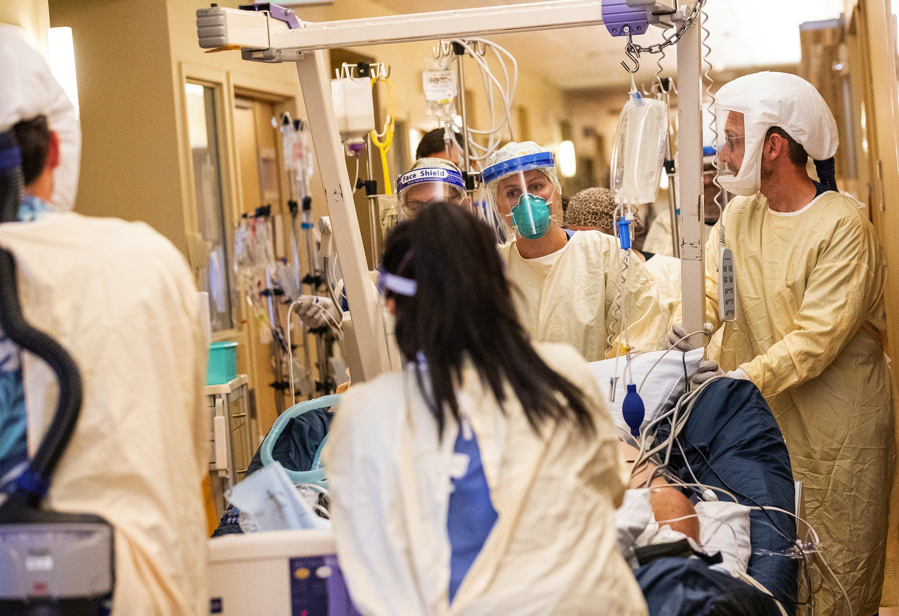SEATTLE — COVID-19 infections and hospitalizations remain on a slow, steady decline in Washington state, but other types of patients still streaming into health care facilities are filling them to near capacity, hospital leaders said Monday.
Hospital beds throughout the state are, on average, about 91% full, with COVID patients taking up about 10%, according to state Department of Health data.
“This problem is not primarily being driven by COVID,” said Taya Briley, executive vice president of the Washington State Hospital Association, during a Monday news briefing. “Right now, our biggest concern is a severe lack of hospital capacity. Our hospitals are bursting at the seams.”
For months, acute-care beds have been taken up by patients who don’t need hospital care, delaying procedures that are “vitally important to the health of our community members,” Briley said.
“We’re concerned that a surge of COVID-19 patients could result in people dying, not because others with a desperate need of hospital care are taking up hospital space, but because nonacute patients who cannot be transferred out of the hospital are taking up hospital space,” she said.
Many patients can’t be discharged from hospitals because of staffing shortages in other facilities, like long-term care centers, creating a backlog of patients with nowhere to go, she said. They include, for example, teens and adults who need inpatient mental health treatment but don’t require hospital care.
“If we were able to move patients out, we wouldn’t have to delay procedures,” Briley said.
Hospital leaders anxious to solve the issue are advocating for legislators in the upcoming 2022 session to smooth out the consent process to move patients stuck in the hospital to long-term care facilities; asking for deployment of state resources to complete patient evaluations faster; and pushing for higher pay for long-term care facility staffers to boost hiring rates, she said.
Fortunately, Briley said, COVID infection and hospitalization numbers have recently remained steady, flattening out since a slight uptick after Thanksgiving. As of Monday morning, the state was averaging about 654 virus hospitalizations in the last week, compared with about 652 the week prior.
COVID deaths remain “stubbornly high,” averaging about 12 to 20 per day.
“It is almost certainly from patients who were sick with COVID during our last surge and have been on ventilators for weeks, a very extended period of time, and are just now succumbing to the disease,” Briley said.
Health care workers throughout the state, meanwhile, say staffing problems persist. Workers who have long called for separate, long-term solutions to address staff burnout said in a Monday webinar that hospital administrators have not adequately responded to their demands — and are now also turning to state legislators for help.
On Monday, a coalition of health care staffers — represented by SEIU Healthcare 1199NW, the Washington State Nurses Association and UFCW 21 — announced a campaign to pass new staffing standards that will protect workers from “dangerously high patient loads.”
“The coronavirus pandemic didn’t create staffing problems; it merely put long-standing problems into a pressure cooker,” said David Keepnews, WSNA executive director. “Starting long before the pandemic, hospital executives have cut staffing to the bone in a shortsighted effort to increase profit.”
According to a new poll released by the coalition, about 84% of state health care workers reported feeling burned out, with nearly 50% saying they’re likely to leave the profession in the next few years. Among those who said they were likely to leave the industry, 70% said one of the biggest reasons was short staffing, according to a statement from the coalition — which is calling themselves the WA Safe + Healthy campaign.
“Most of us will tell you that we think nursing is a calling,” said Julia Barcott, a critical care nurse at Astria Toppenish Hospital in Yakima County. “I myself feel that way. But too many of us have started to wonder why we’re in this profession.”
The campaign is still in the process of finalizing legislation, but said Monday they’ll be asking the state to enforce existing overtime, meal and rest break laws — ending the “abuse of mandatory overtime” — and invest in workforce development to up the number of health care workers entering the field, among other requests.
“I’ve been a nurse for 26 years, and I’ve never seen so many colleagues leaving,” Barcott said in a statement. “ … This has meant that we are scrambling to cover our patients’ needs — it’s bad for nurses and healthcare workers, and it’s bad for patients.”



